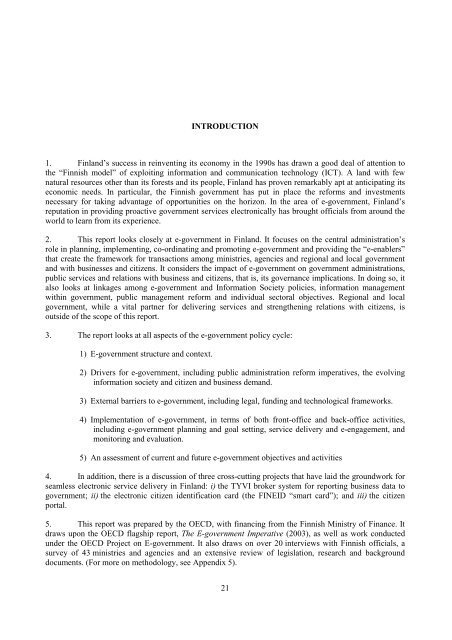e-GOVERNMENT IN FINLAND - ePractice.eu
e-GOVERNMENT IN FINLAND - ePractice.eu
e-GOVERNMENT IN FINLAND - ePractice.eu
Create successful ePaper yourself
Turn your PDF publications into a flip-book with our unique Google optimized e-Paper software.
<strong>IN</strong>TRODUCTION<br />
1. Finland’s success in reinventing its economy in the 1990s has drawn a good deal of attention to<br />
the “Finnish model” of exploiting information and communication technology (ICT). A land with few<br />
natural resources other than its forests and its people, Finland has proven remarkably apt at anticipating its<br />
economic needs. In particular, the Finnish government has put in place the reforms and investments<br />
necessary for taking advantage of opportunities on the horizon. In the area of e-government, Finland’s<br />
reputation in providing proactive government services electronically has brought officials from around the<br />
world to learn from its experience.<br />
2. This report looks closely at e-government in Finland. It focuses on the central administration’s<br />
role in planning, implementing, co-ordinating and promoting e-government and providing the “e-enablers”<br />
that create the framework for transactions among ministries, agencies and regional and local government<br />
and with businesses and citizens. It considers the impact of e-government on government administrations,<br />
public services and relations with business and citizens, that is, its governance implications. In doing so, it<br />
also looks at linkages among e-government and Information Society policies, information management<br />
within government, public management reform and individual sectoral objectives. Regional and local<br />
government, while a vital partner for delivering services and strengthening relations with citizens, is<br />
outside of the scope of this report.<br />
3. The report looks at all aspects of the e-government policy cycle:<br />
1) E-government structure and context.<br />
2) Drivers for e-government, including public administration reform imperatives, the evolving<br />
information society and citizen and business demand.<br />
3) External barriers to e-government, including legal, funding and technological frameworks.<br />
4) Implementation of e-government, in terms of both front-office and back-office activities,<br />
including e-government planning and goal setting, service delivery and e-engagement, and<br />
monitoring and evaluation.<br />
5) An assessment of current and future e-government objectives and activities<br />
4. In addition, there is a discussion of three cross-cutting projects that have laid the groundwork for<br />
seamless electronic service delivery in Finland: i) the TYVI broker system for reporting business data to<br />
government; ii) the electronic citizen identification card (the F<strong>IN</strong>EID “smart card”); and iii) the citizen<br />
portal.<br />
5. This report was prepared by the OECD, with financing from the Finnish Ministry of Finance. It<br />
draws upon the OECD flagship report, The E-government Imperative (2003), as well as work conducted<br />
under the OECD Project on E-government. It also draws on over 20 interviews with Finnish officials, a<br />
survey of 43 ministries and agencies and an extensive review of legislation, research and background<br />
documents. (For more on methodology, see Appendix 5).<br />
21
















